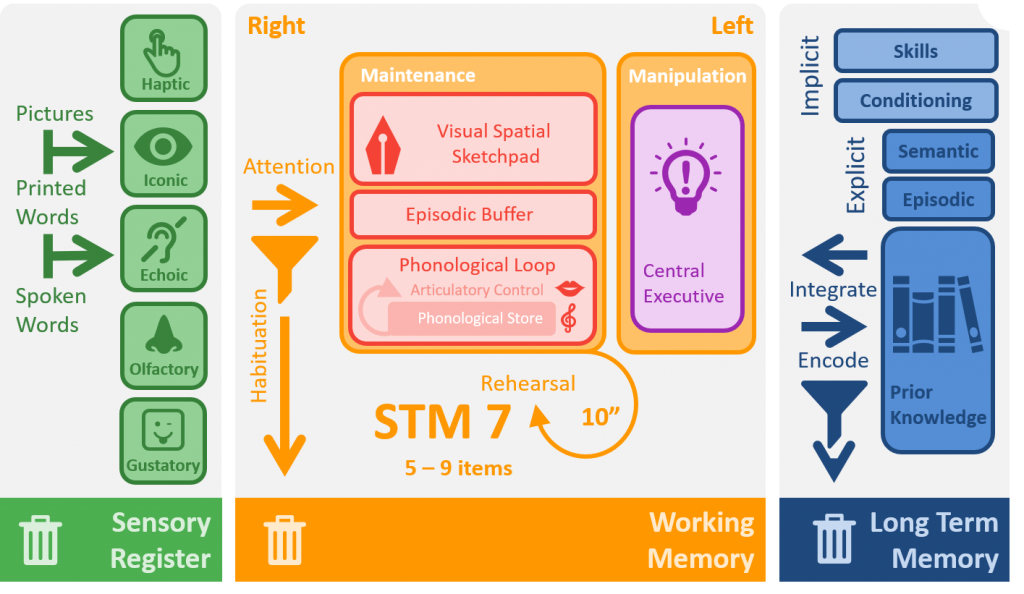Our brain is self-organizing using Neuroplasticity trough long term Potentiation, keeping hold of knowledge or depression by removing irrelevant knowledge.

Like on a computer system that has input devices to enter data, data has to be entered in our brain. This is not done by input devices but by receptors (eyes, ears, nose, tongue, skin) they receive millions of pieces of information that are delivered to the sensory memory. The Iconic Sensory Register is the most dominant and can hold information for 0.25 seconds. Echoic Sensory Memory can hold information up to 3 seconds. Receiving millions of pieces of information is much more information than what your brain can can process at any one time. Thus, you must make choices (conscious and unconscious) driven by stimuli to which information you will pay attention.
It is good to remember that people don’t pay attention to boring things. People can also can get used to sensory stimuli, leading to habituation. Habituation will stop the information of being further processed.
Sensory information that captures your attention flows to your Short Term Memory. Your Short Term Memory can remember 5 to 9 chunks for 10 to 15 seconds. Rehearsal is thus from the utter most importance. Decreasing the chunk count by Increasing the chunk size can increase the performance. When presented with new sensory data ,you will most of the time remember the first (primacy) and the last item (recency). Working Memory is used for information processing (Bradleys model) where the visual spatial sketchpad (visual) helps you to process and store visual objects and locations. The phonological loop (verbal) is for sound or linguistic information. The episodic buffer helps us to bind visual and verbal information. The central executive drives the flows between these working memory components and gives priority to particular activities.
Dual-coding theory
A number of studies have shown that learning is depressed by an average of 79% when a graphic is explained by both on-screen text and a duplicative audio narration. Why? Learners can only process one thing visually at a time. If they’re reading the text, they can’t look at the graphics simultaneously. However, presenting the text as audio narration lets learners process it with their ears, and frees their eyes to focus on the graphic being explained. Enabling dual coding, this is a theory put forward by Allan Paivio that argues that recall and recognition are better if both verbal and visual channels are engaged.
Phonological Loop Overload
The phonological loop consists of two sub-stores: the articulatory control system, which controls speech, and the phonological store, which is the inner ear, responsible for the voice in your head. Reading requires use of the phonological store (when you read, you “hear” the words in your head), and speaking utilizes the articulatory control system.
Both the phonological loop and visuo-spatial sketchpad have a limited capacity. This means they can only process a limited amount of information at one time. For example, you can’t listen to two conversations at once. In this case, reading and listening at the same time is too much for the phonological loop. However If you were to attempt to draw and speak at the same time, you’d find it quite easy, since the information from drawing and speaking are processed in different stores.
The working memory will help us to screen, generalize, specify and match information. But also produce ideas, represent ideas from and record ideas to long term memory. Only ideas that make sense and that are meaningful will be recorded. Recording is triggered by using repetition and elaboration, when emotionally attached to ideas the recording will be stronger and faster. During the encoding of new ideas the brain attempts to connect the new ideas to prior knowledge. Encoding information in the long term memory can be done in different ways: acoustic, visual, semantic and are associated with cues, context, mood, emotion, mental states. Allowing us to retain the information in the implicit and explicit subsystems.
The Explicit subsystem is declarative, with a conscious recall:
- Semantic: Facts, General knowledge
- Episodic: Personally experienced events
The Implicit subsystem is without conscious recall, without awareness:
- Skills: Motor and Cognitive
- Conditioning: Dispositions- classical and operant conditioning effects
- Procedural
- Perceptual: Improvement in ability to process sensory input.
The long term memory may have an almost unlimited storage, but it must be retrievable.
Long Term Memmory becomes unusable when:
- We are missing the original cues, context, mood, mental state.
- Experience interference: where old and new knowledge clash and one of the 2 will be removed
- Source amnesia: when we attribute the wrong source to good memories
- False memories: make unconscious and false connections from historical knowledge
When you encode your ideas in more ways, the more ways there are for retrieving it. Elaborating on information with the use of exams is another great technique, that enhances idea recording.
In your eLearning make sure that you help the learner to encode your ideas (content) in mulitple ways by using visuals and sounds, while avoiding visual text that is narrated. Let learners eloborate on content with exercesise and tests. Connect the ideas to prior knowledge while avoiding interference. And don’t forget to make it emotional, make them care!
Icons made by Freepik from www.flaticon.com is licensed by CC 3.0 BY
I really like this post. Putting lots of text on a screen is just a stone’s throw away from PowerPoint and bullet points, which is the antithesis (I believe) of great e-learning. However I am slightly biased as I’ve always worked in creating graphics! A picture is worth ten thousand words 🙂
You must be logged in to post a comment.









